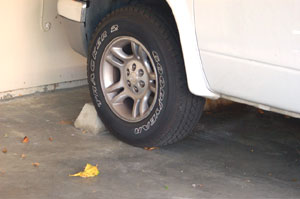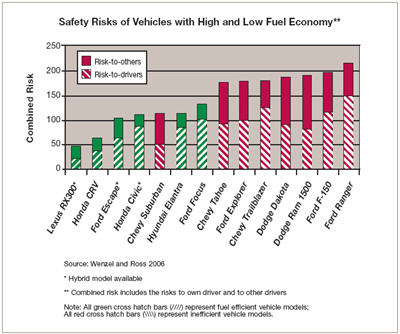 One of the benefits of being on the staff of a nonprofit that is a guest at Lawrence Berkeley National Laboratory is rubbing elbows with great scientists and researchers like Tom Wenzel in the Environmental Energy Technologies Division. I first met Tom after a talk he gave years ago about improving auto fuel economy without sacrificing safety. (Tom recently briefed U.S. Congressional staff preparing to debate legislation on increasing corporate average fuel economy (CAFÉ) standards.) Etched in my mind is a graph he displayed showing the relative safety of most car models. Each model is rated according to how many drivers are killed in accidents involving that model car or light truck-- including those in the car or truck and those in other cars involved in the accident (see Figure).
One of the benefits of being on the staff of a nonprofit that is a guest at Lawrence Berkeley National Laboratory is rubbing elbows with great scientists and researchers like Tom Wenzel in the Environmental Energy Technologies Division. I first met Tom after a talk he gave years ago about improving auto fuel economy without sacrificing safety. (Tom recently briefed U.S. Congressional staff preparing to debate legislation on increasing corporate average fuel economy (CAFÉ) standards.) Etched in my mind is a graph he displayed showing the relative safety of most car models. Each model is rated according to how many drivers are killed in accidents involving that model car or light truck-- including those in the car or truck and those in other cars involved in the accident (see Figure).
 The safest cars are the ones with the most safety features-- passenger cars with names like BMW, Mercedes Benz, and Lexus. The least safe are large SUVs and pick-up trucks-- which, with their high centers of gravity and difficulty in handling tend to rollover in an accident--and less expensive sub-compact cars. Auto safety has evolved from seat belts to air bags to electronic stability control. Each new technology starts as an option and then becomes standard. The current trend in auto safety is to replace dangerous truck-based SUVs with crossover versions based on car platforms. The crossover SUVs are safer, both to their own and other drivers, and have about 20% higher fuel economy for the same interior volume, as conventional truck-based SUVs. Go figure! Other changes in vehicle design can improve the fuel economy and safety of all vehicle types, including the largest pickups.
The safest cars are the ones with the most safety features-- passenger cars with names like BMW, Mercedes Benz, and Lexus. The least safe are large SUVs and pick-up trucks-- which, with their high centers of gravity and difficulty in handling tend to rollover in an accident--and less expensive sub-compact cars. Auto safety has evolved from seat belts to air bags to electronic stability control. Each new technology starts as an option and then becomes standard. The current trend in auto safety is to replace dangerous truck-based SUVs with crossover versions based on car platforms. The crossover SUVs are safer, both to their own and other drivers, and have about 20% higher fuel economy for the same interior volume, as conventional truck-based SUVs. Go figure! Other changes in vehicle design can improve the fuel economy and safety of all vehicle types, including the largest pickups.
So why am I writing about cars, when my area of expertise is houses? Let me count the reasons. People live many hours in their cars, which not only use energy for transporting people and things, but also use energy for heating, cooling, and entertaining, just like houses do. Cars sleep in garages that are attached to houses. As electric cars and plug-in hybrids become more popular, the electricity load in homes will increase. And where we live determines the length of our commute to work. Cars and houses go together like peas and carrots!
Here's a suggestion for all of you out there who are deciding whether to live in an affordable home, condo, or apartment an hour away from your job, or getting in over your head financially to live close to your work. When you are looking at new homes out in Antioch or Brentwood, ask your realtor, "Does this house come with a Prius?"
![]() Jim Gunshinan is Managing Editor of Home Energy Magazine. He holds an M.S. in Bioengineering from Pennsylvania State University, State College, Pennsylvania, and a Master of Divinity (MDiv) degree from University of Notre Dame.
Jim Gunshinan is Managing Editor of Home Energy Magazine. He holds an M.S. in Bioengineering from Pennsylvania State University, State College, Pennsylvania, and a Master of Divinity (MDiv) degree from University of Notre Dame.
